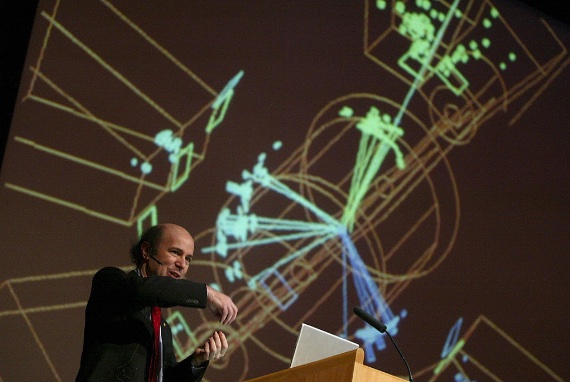We all know what a crystal is. We can explain it with varying degrees of clarity, but the idea is simple because it is intuitive: a material whose atoms are arranged in a regular pattern that repeats in space and determines its macroscopic geometry, as in table salt, a snowflake or a diamond. But since time is a fourth dimension in physics, in addition to the three spatial ones, if crystals exist in space, why not in time? This was the far from simple or intuitive idea of physicist Frank Wilczek, an idea that was challenged at the time and later modified in a way that has been applied to real systems. And while it is debatable whether it is correct to talk of time crystals, this is new physics with interesting potential applications.
In 2012, Wilczek, a professor at the Massachusetts Institute of Technology and a physicist renowned for his Nobel Prize in 2004, went public with an idea in the journal Physical Review Letters that he himself considered strange and somewhat embarrassing: time crystals. The principle involved applying the concept of a crystal to time, which in turn is based on an idea that is often repeated in physics, namely symmetry breaking. An example: liquid water is symmetrical; it looks the same in any spatial direction. But this absolute symmetry is broken when it crystallises into ice, which has a regular structure, not continuous, but with a repeated periodicity in space.

Wilczek proposed, and presented mathematically, the case of a material with a repeated periodicity in time, like an eternal ticking with a regular interval. In a commentary on Wilczek’s study, physicist Jakub Zakrzewski of the Jagiellonian University in Kraków (Poland) explained that symmetry breaking is easy to understand when dealing with systems that are far from equilibrium: they lose energy and increase their entropy according to the second law of thermodynamics. For example, the orbits of planets are not circular, but elliptical; over billions of years, the system tends towards equilibrium.
But spontaneous symmetry breaking, Zakrzewski continued, is observed in nature in systems in equilibrium, which are in their ground (or lowest energy) state. A crystal is a common example. The workings of thermodynamics make it possible for a snowflake to form, even though it is a more ordered, less symmetrical state. “Since we have gotten used to considering space and time on equal footing, one may ask whether crystalline periodicity can also occur in the dimension of time,” he wrote.
Main criticisms
Wilczek’s key idea, the Polish physicist explained, “is to search for systems that are spatially ordered and move perpetually in their ground state in an oscillatory or rotational way.” In other words, a new state of matter comparable to a tiny atomic clock that would move endlessly, without the need for energy input, because that would be its ground state.
Of course, Zakrzewski underlined the main objection: “Time crystals may sound dangerously close to a perpetual motion machine.” At least since the Middle Ages, inventors have been trying to create a machine that would run constantly without consuming energy. The laws of thermodynamics proved that such a thing is not possible, and today there is not the slightest scientific doubt about this. But according to Zakrzewski, in the case of time crystals there would be an essential difference: “While time crystals would indeed move periodically in an eternal loop, rotation occurs in the ground state, with no work being carried out nor any usable energy being extracted from the system.”

But some physicists did not buy the exception. Patrick Bruno, head of the Theory Group at the European Synchrotron Radiation Facility in Grenoble, France, was from the outset a vocal critic of time crystals. Wilczek’s idea, Bruno tells OpenMind, “was just plain wrong as I demonstrated. Wilczek’s proposal was just another perpetual motion machine, something that is prohibited by the fundamental laws of physics.” Other scientists later corroborated Bruno’s refutation.
Discrete time crystals
After it was realised that Wilczek’s idea was not valid, a variation was introduced in 2016: the time-crystalline behaviour would be triggered by adding a small dose of energy to the system, so that the spin of the particles would be periodically reversed, like a kind of quantum pendulum. In other words, these systems would be far from equilibrium, unlike Wilczek’s proposal. This new version gave rise in 2016 to the first two practical models, based respectively on a chain of ytterbium atoms excited by lasers, and on applying microwaves to impurities in a diamond. In both cases, a repeated oscillation was induced with a periodicity different from that of the stimulus.
These discrete time crystals, as they have been called, have given rise to several examples in recent years. Researchers have explored their properties and their possible real-world applications in fields such as quantum computing. But according to Bruno, they should not be called time crystals since they do not correspond to Wilczek’s original proposal. “We have known for centuries that systems out of equilibrium can spontaneously oscillate,” he says. “This is just different physics, some of it quite interesting, but not as novel as claimed, and generating some hype that is not justified in my opinion. ” For the physicist, the continued talk of time crystals “is just hot air.”
Ultra-thin photonic time crystals
Time crystals or not, the field is generating breakthroughs that have their seed in the spark ignited by Wilczek. Among the latest is a system created by a team from Aalto University (Finland), Stanford University (USA) and the Karlsruhe Institute of Technology (Germany). In so-called photonic time crystals, it is the electromagnetic properties of the material that oscillate over time, that is, what the material does with light.

Previous photonic time crystals were very bulky, lead author Xuchen Wang tells OpenMind. “This made it difficult to implement them practically,” he says. “Our system uses a 2D ultra-thin film structure, which has similar properties to the 3D photonic time crystals but is easier to fabricate and easier to change the material properties.”
The magic of the ultrathin crystal developed by Wang and his collaborators is that it exponentially increases the amount of light incident on it. “This could lead to the development of new types of lasers that don’t require a traditional cavity structure with reflecting mirrors,” he says. Wang adds that it could be “integrated into advanced wireless communication systems to amplify communication waves and improve efficiency.” Call them time crystals or whatever you like, one researcher is already suggesting that we may one day carry them around in our smartphones.
Comments on this publication